When and how to plant hyacinths in spring and autumn in open ground: optimal timing, planting and growing rules
With the arrival of spring, hyacinth or the so-called "rain flower" appears on store shelves. This is a miracle of miracles, which has something to admire: a rich palette of magnificent inflorescences of flowers-stars and juicy bright emerald foliage. The strong pleasant aroma is also delightful.
So, if you are imbued with the idea of growing a symbol of spring, love and fidelity in your summer cottage, you will be interested in familiarizing yourself with some tips and recommendations for the correct planting of hyacinths in open ground in autumn and spring.
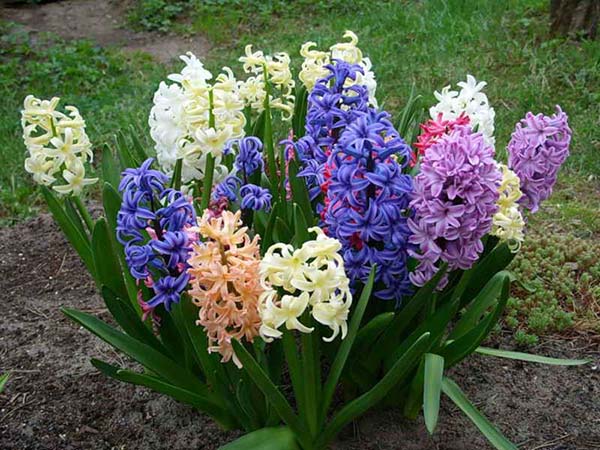
Content
Types and varieties of hyacinths
Today, as a rule, only 3 varieties of hyacinths are distinguished:
- Eastern (Hyacinthus orientalis);
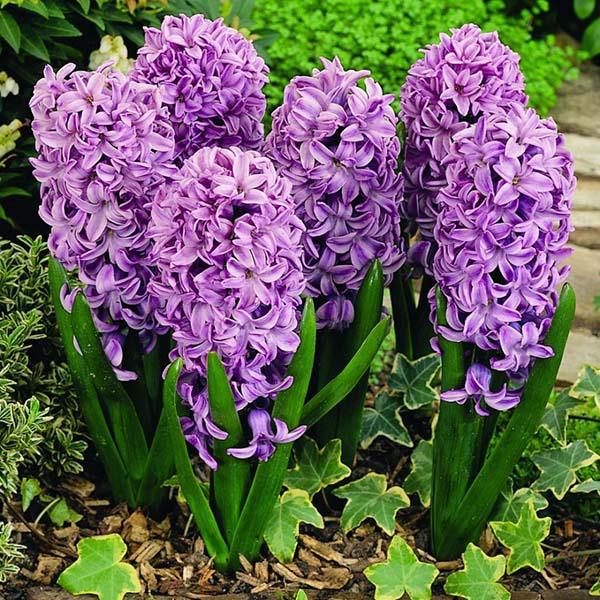
Splendid Cornelia cultivar - Litvinov (Hyacinthus litwinowii);
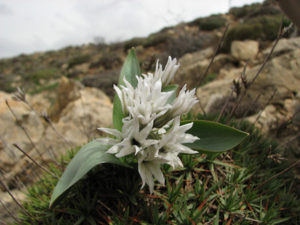
- Transcaspian (Hyacinthus transcaspicus).
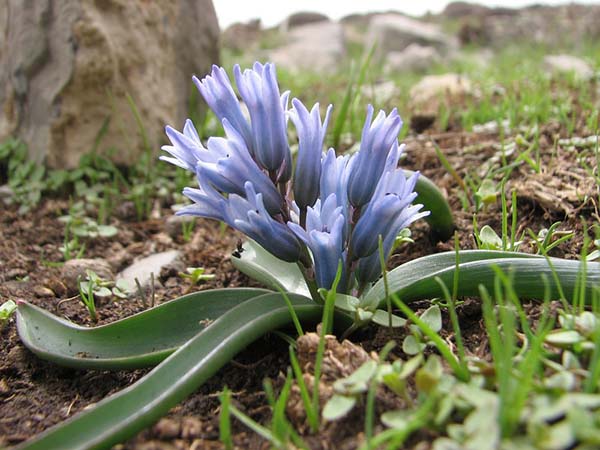
The most famous and suitable for cultivation in our gardens and home conditions in pots is the oriental hyacinth.
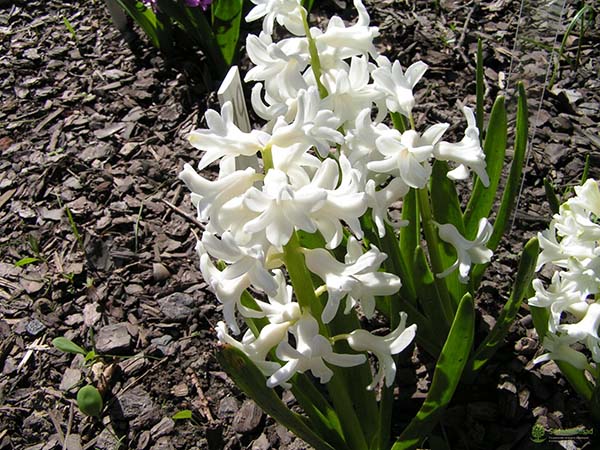
There is a fairly large number of varieties of the oriental variety, which in turn are divided by size, color and color of flowers (white, yellow, red, pink, blue, purple, blue, etc.), as well as by the timing of flowering in the early-medium and late flowering, while the difference between their flowering is only one and a half weeks. Therefore, if you do not have the opportunity to arrive at the dacha early to catch their flowering, it is better to choose late varieties.
When to plant hyacinths: optimal planting dates in autumn and spring
Naturally, like all bulbous, hyacinths are planted in the fall before winter. In this case, you need to choose a time so that the bulbs have time to take root, but do not germinate. That is, if you do this earlier than the necessary time, then the frosts will simply destroy the plant that has sprouted, and if later, then the bulbs will not have time to take root and will freeze again. Therefore, it is very important to know the optimal dates for planting hyacinths in the fall, which will differ depending on the region of your residence and the corresponding climate and weather conditions.
Important! If you have planted the bulbs at the right time, but suddenly, according to the weather forecast, a sharp cold snap is expected, then you should increase the layer of mulch or cover the plantings with spruce branches or fallen dry leaves.
Thus, in the middle lane (Moscow region), hyacinths should be planted in the second half of September - early October, in the Urals and Siberia - in late August and early September, and in the southern regions - throughout October.
Is it possible to plant in spring and how to do it
If you were presented with blooming hyacinths in a pot (for example, on March 8 or some other spring holiday), then after they have faded, in order to preserve the bulbs, the plant can be planted in open ground. To do this, you first need to cut the peduncle so that it does not take excess nutrition from the bulb. Take out the hyacinth bulbs together with the earthen clod and bury them at the same depth at which they grew in the pot, having previously poured a layer of sand on the bottom as drainage. Then cover it with nutritious soil and water it, moistening the soil around the bulb, and not itself. If suddenly, according to the weather forecast, you find out that return spring frosts are expected, then on this day it is better to cover the plant bulbs with non-woven material. When you see that their leaves are dry, then you should get rid of them by removing with pruners or scissors.
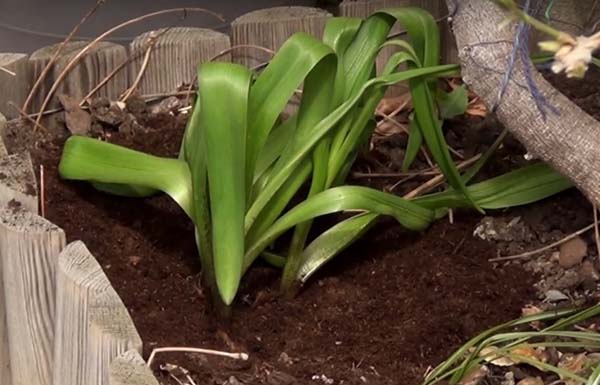
Advice! If for some reason you do not want to plant hyacinths in the spring, then you can do otherwise. Wait until the leaves of the plant dry up and cut them off. After that, get the bulbs, dry them and store them until autumn planting.
Video: planting hyacinths in spring
How to plant hyacinths in open ground
In order to enjoy the beautiful flowering and the beloved aroma of hyacinths for a long time, it is necessary to provide for the most suitable place for planting, as well as prepare the bulbs themselves and the soil for further work.
Landing place
A properly selected planting site can greatly facilitate the cultivation of hyacinths in the garden. At home, these bulbs grow in a very warm and dry climate, so they must be planted in sunny areas, without drafts, where there is not the slightest stagnation of water, otherwise the flowers can rot very quickly due to the presence of a very thin skin.
Many people plant hyacinths under trees because they bloom at a time when there is still no dense foliage. However, it should be borne in mind that trees suck out almost all nutrients from the soil.
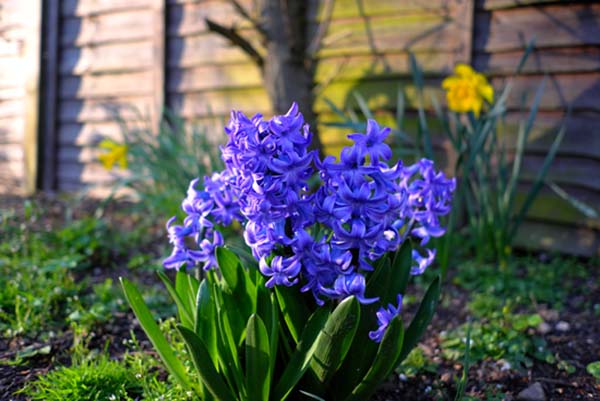
These bulbous flowers look good on flower bed made of plastic bottles.
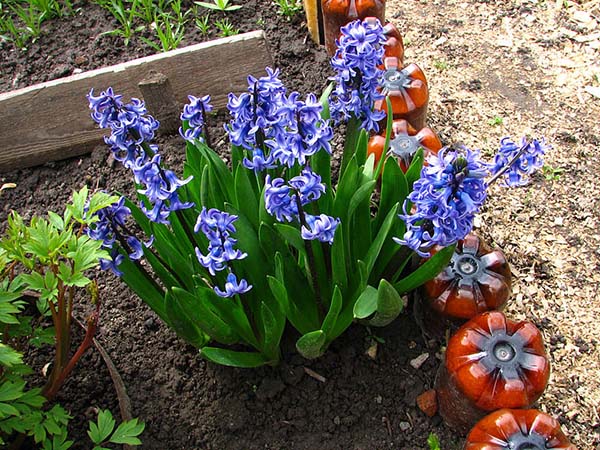
As for the neighborhood, it is beautiful to plant hyacinths with other primroses, for example, with hazel grouses, crocuses, daffodils, bulbous irises.
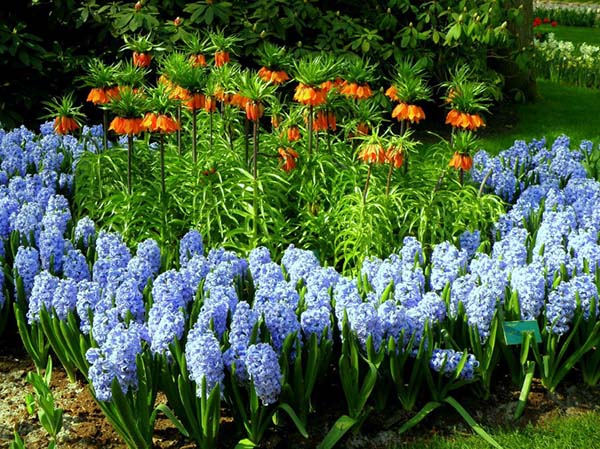
You can put them in a flower bed of tireseg withtulips.
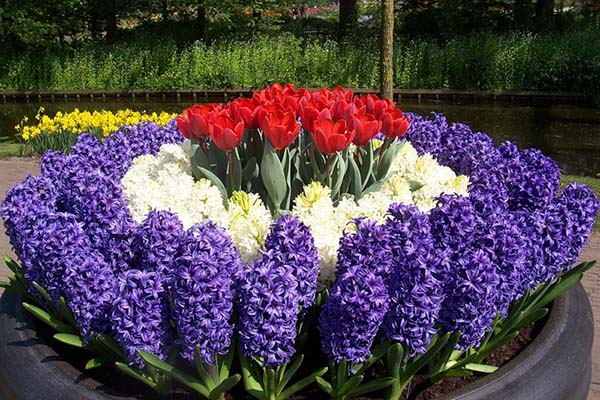
By the way! You can grow hyacinths both in large garden pots and in small containers at home on a windowsill or balcony.
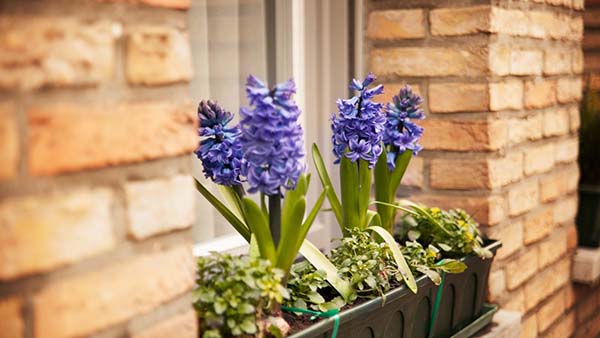
Soil preparation
Hyacinths need a neutral soil, and it is imperative that it be loose and moisture-permeable, in other words, the most suitable is sandy loam.
Before planting, it is advisable to dig up the earth to a depth of 25-30 centimeters (bayonet of a shovel) and apply organic fertilizers - compost, humus or peat, wood ash, as well as mineral - superphosphate, potassium sulfate (if there is no ash), or complex - nitroammofosk (16% of each macronutrient) or diammofosk (10% nitrogen, 26% potassium and phosphorus). And if the soil is heavy (clayey), then the sand is too acidic - limestone (dolomite) flour or again more wood ash.
Important! In no case should you bring fresh manure, only rotted (3-4 years old) for digging and planting bulbous ones.
Selection and preparation of bulbs for planting
Naturally, the purchased onion should be outwardly dry, clean and healthy (without signs of disease and damage, especially at the bottom), and dense and elastic to the touch.
If you want the hyacinth to bloom immediately, it is recommended to choose 4-5 cm bulbs, 2-3 cm bulbs are very young, there will be few flowers, but you should not buy too large 6-7 cm bulbs, these are already quite old specimens that are about to be updated.
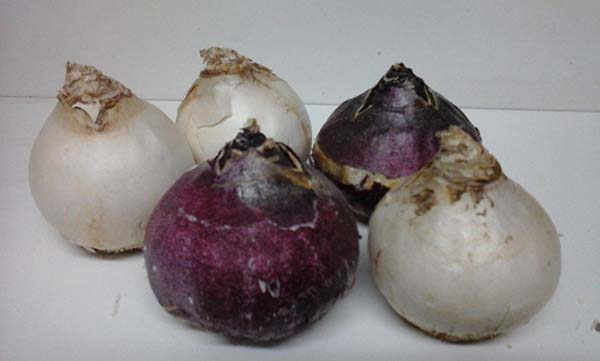
Thus, the higher quality planting material you purchase, the better the plant will look and flourish.
And before planting hyacinths, the bulbs should be pickled and disinfected in a solution of one of the special fungicides, for example, Maxim Dachnik, Fundazol, or in the old-fashioned way in potassium permanganate for 20-30 minutes.
Direct planting of bulbs
Step-by-step instructions for planting hyacinths in open ground:
- Decide on a place in your summer cottage, dig up and improve the soil, make planting holes.
- Prepare and process the bulbs.
- At the bottom of the hole, drain the sand (2-3 centimeters).
- The planting depth of hyacinths is 3 times the height of their bulb, that is, if the bulb is 4 cm high - 12 centimeters, 5 cm - 15 centimeters. However, if your soil is light, then you can plant deeper, and if, on the contrary, it is heavy, then closer to the surface - about 2-3 centimeters.
- The distance between the bulbs should approximately correspond to the depth of their planting, that is, somewhere 10-20 centimeters from each other, depending on the size.
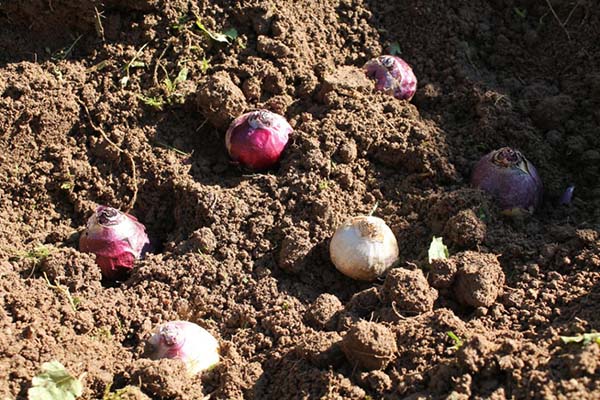
- Place the bulbs on the sand, sprinkle it with sand on top (so as not to decay), and only then cover it with fertile soil.
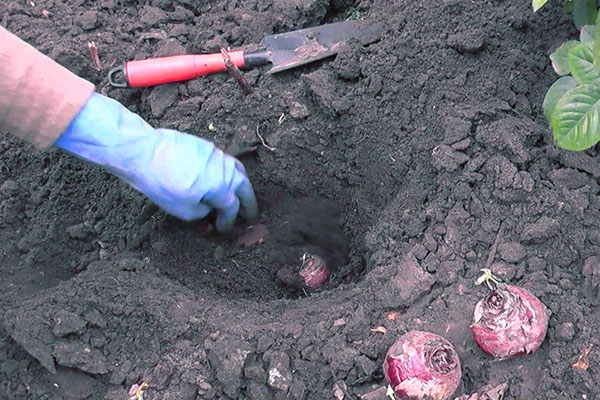
- Water the planting site if the ground is dry (if it has recently rained, then this should not be done).
- Mulch with peat or sawdust.
Video: planting hyacinths in open ground in the fall
If you want to make yourself a portable flower bed that you can move depending on which part of the garden you are in (near the house, next to the gazebo), or just dig into the ground (because you like the aesthetic appearance of flowers in a pot), then watch the next video.
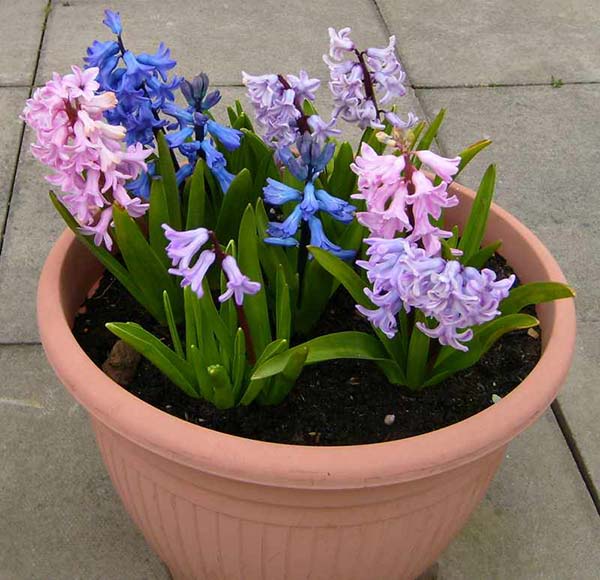
Video: a method of planting hyacinths in large garden pots
Outdoor hyacinth care
Some time after the autumn planting, when the first cold snap begins, if you have not previously mulched your future flower bed with hyacinths, you need to do this now, or even better, cover it with spruce branches or dry fallen leaves (you should not do a heavy shelter), you can use straw.
And in early spring, when the snow melts and you first come to the dacha, the entire shelter will need to be eliminated so as not to interfere with the sprouts making their way towards the sun.
Blossoming of hyacinths, as a rule, occurs in April-May, and the duration is only 1-2 weeks.
Advice! There is a little trick on how to get bigger and taller colors.Namely, in the period before the beginning of budding, you need to cover the flowerbed with hyacinths with a dark (black) film, due to a lack of light, the sprouts will begin to stretch, thereby the peduncles will noticeably increase in height.
Watering
Watering hyacinths should be taken seriously, stagnation of moisture is contraindicated for bulbs, but the earth should not dry out, so try to moderately and shallowly moisten the flower bed. Especially often (but not abundantly) it is necessary to water the plant during the period of its budding and the beginning of flowering, as well as within 2 weeks after.
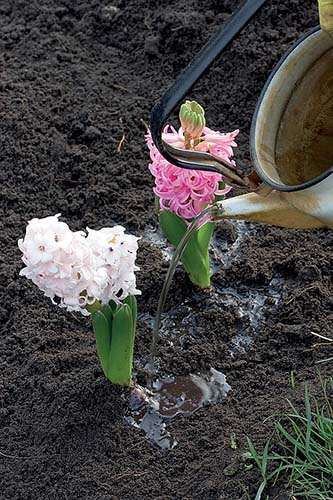
Advice! Do not forget to loosen the soil after each watering so that the earth does not crack and the flower bed looks beautiful.
Top dressing
Top dressing is a very important point in hyacinth cultivation. The standard scheme looks like this (* the consumption of any mineral fertilizer is about 40 grams per 10 liters of water, or better according to the instructions on the package):
- The first top dressing must be done immediately after the first shoots appear, at this moment the plant needs nitrogen to grow the leaf mass (for example, it can be urea, ammonium nitrate, or some kind of green fertilizer).
- The second time is fed shortly before flowering, that is, during the budding period - to obtain lush flowers. At this point, the plant needs a complex nitrogen-potassium-phosphorus feeding (more potassium) and a little nitrogen (for example, you can use nitroammofoska, or potassium chloride / sulfate and superphosphate, also, as an option, will do wood ash).
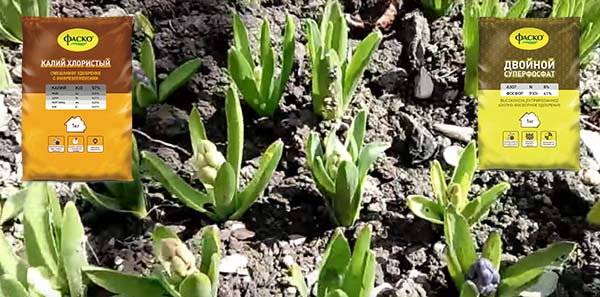
- The last (third) top dressing is at the end of flowering. The plant needs more phosphorus and a little potassium (i.e. superphosphate and potassium chloride / sulfate or ash).
Thus, if you water and feed hyacinths in a timely manner, they will delight you with their beautiful, lush and fragrant flowering.
And after flowering, be sure to cut the peduncles so that the plant directs all its forces to provide the bulb. Now it remains to wait until the leaves of the flowers wilt and turn yellow, so that they can be dug up for the summer before the next autumn planting.
When to dig up and how to store hyacinth bulbs
By the way! If crocuses and daffodils you can not dig it up for 3-5 years, then hyacinths are advised to disturb and get out of the ground yearly... Although some growers have been successful in allowing these bulbs to grow in the garden until 3 years old, but it should be understood that a flower bud is laid only if the bulb lies for 3 months in a warm and dry room.
Bulbs of hyacinths, as a rule, are carefully dug up (stepping back from the bush by 8-10 centimeters) after they have withered, dry up (but not completely) and the leaves turn yellow (about May-June, about 3 weeks after flowering). Then they should be thoroughly rinsed under water in order to immediately discard low-quality bulbs.
Now the future planting material needs to be disinfected in one of the special means, such as Maxim Dachnik or Fundazol, or to prepare a pink solution of potassium permanganate. Then dry well, and before the mortgage itself for storage, peel (if desired, you can wrap it in newspaper) and put the bulbs in boxes (for example, from under shoes), bags or containers and store them in a warm and dry place. It is noteworthy that the first time you need to store at a sufficiently high temperature (+25 - .. + 30 degrees), and then gradually lower it, so that before disembarking it was about +17 degrees.
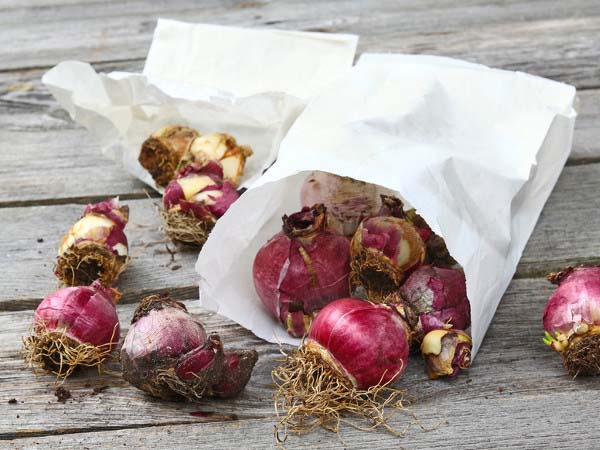
If during the digging you see babies on the bulbs, then you can separate them and thereby multiply the hyacinths, preserving them in the summer and planting them separately in the fall.
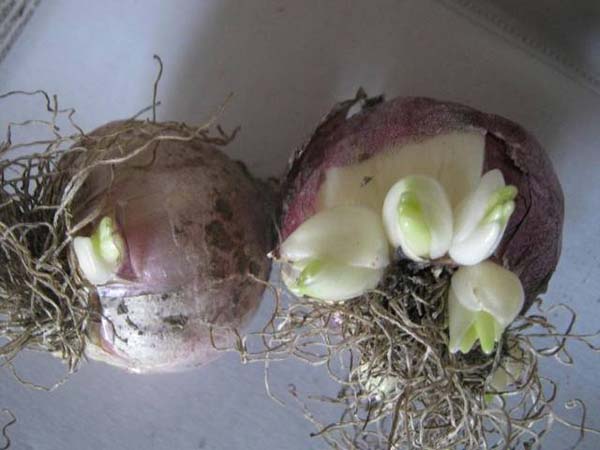
If you purposefully decided to start growing hyacinths in the open field in the fall and spring, then choose the right variety and correctly determine the timing of planting in the ground. It would also be very wise to prepare the bulbs and soil for planting in advance. It is equally important to know how to store hyacinths.
Video: planting, care, cultivation, digging and storage of hyacinths

